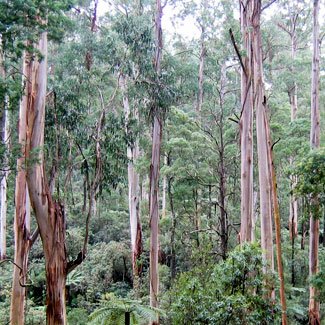World’s tallest flowering plant more fire-proof than thought

THE MOUNTAIN ASH, a towering eucalypt species endemic to south-eastern Australia, is better equipped to survive low intensity bushfires than many botanists assumed, say researchers.
“People had previously suggested that the mountain ash was a poor re-sprouter,” says Dr Geoff Burrows, a botanist at Charles Sturt University in Wagga Wagga, NSW. “I thought that sounded a bit peculiar, given what we know about eucalypts, so I went looking for myself.”
Eucalypts are known for their ability to survive intense fires, with new shoots emerging from blackened trunks within months of a blaze. This regenerative capacity comes from specialised bud cells deep in their bark. Rare in other plants, these cells are characteristic of eucalypts, which frequently face fire.
Poor resprouter
According to Geoff, botanists had assumed that the mountain ash didn’t have these buds. It was thought that they could only return by growing from seed, resulting in a regrowth forest of uniform age.
Botanist Dr Russell Sinclair, from the University of Adelaide, agrees
this has been a commonly held view. “I knew that mountain ash was known
to usually be killed by fire and regenerate from seed, and I assumed,
as many did, that this was due to a lack of [regenerative] buds.”
In
recent years, however, research projects have found that mixed-age
mountain ash forests are relatively common. This hinted that older
trees had survived less intense fires, re-sprouting from stems and
branches “and continued to grow, along with a new batch of seedlings,”
says Geoff.
To confirm this, he led a team that studied three adult trees and two saplings. The project uncovered the same specialised, fire-proof buds that are found in other eucalypts. The study will be published in the print edition of American Journal of Botany next month.
Heritage revealed
The mountain ash “showed its fire-adapted, typical eucalypt heritage,” Geoff told Australian Geographic. Instead, he says, the poor re-sprouting capacity derives from an unusual thinness of bark on higher parts of the tree; this makes it susceptible to destruction if flames reach the canopy.
However, mature trees have much thicker bark on their lower trunks, to a height of about eight metres. This is thick enough to shield the base from low intensity bushfires that only burn the understorey.
The new study also found that this protective ‘skirt’ only develops late in life, making younger trees vulnerable. “It seems that mountain ash put most of their energy into growing very tall, very quickly as young plants, leading to these incredibly slender saplings and trees,” he says.
Russell agrees the finding is valuable. “It is intriguing to find that the trees do in fact have these specialised bud-forming cells like most other eucalypts,” he says.
These findings won’t affect the way Australia manages its forests, “but it’s interesting and important for us to learn more about how eucalypts regenerate… and respond to fires of differing intensity,” says Geoff. “It’s what’s special about them, and is an integral part of how they’ve come to dominate the Australian bush – they outcompete other species that can only regenerate from seed or from the stump.”

